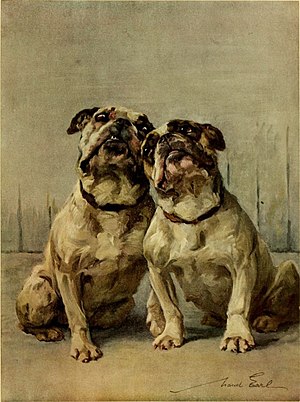The power of the dog/The Miniature Bulldog
"Some there are who do thus in beauty love each other."
Maeterlinck
MINIATURE BULLDOGS
"Champion Chevet Punch" & "Chevet Daisy"
Owned by Lady Kathleen Pilkington
THE MINIATURE BULLDOG
"Which I have a small favour to ask you,
As concerns a bull-pup, and the same,—
If the duty would not overtask you,—
You would please to procure for me, game;
And send her express to the Flat, Miss,—
For they say York is famed for the breed,
Which, though words of deceit may be that, Miss,
I'll trust to your taste Miss, indeed."
Bret Harte.
THE rage for bantamising things has occupied the minds of men for countless generations. Japan has sent us dwarf trees and bantam fowls. Great dames of Egypt, and, later, of Greece and Rome, had their toy dogs, some of which were miniature editions of larger varieties. We, too, have pursued the same custom, with our toy spaniels, toy terriers, and now miniature bulldogs. You must not call these little midgets "toys" unless you would offend the susceptibilities of those who favour them. The objection to the employment of this word in such a connection is perfectly valid, for, in the real sense, the miniature bulldog is not a toy at all; he is merely a replica in little of the bigger brother from whom he has sprung. His lineage is as pure, his pretensions to breeding as justifiable. Probably if the French bulldog had never been imported we should have heard nothing of the miniature. Somewhere about 1893 the late Mr. G. R. Krehl exhibited a team of the small Parisians under the name of French Toy Bulldogs, but it did not take long to see that, whatever may have been the origin of these dogs, in the intervening years they had departed very materially from the accepted bulldog character. The wide, upward sweeping underjaw of the national breed was absent, and the ears! In the eyes of the orthodox these indispensable members were everything they should not be. The erect, commonly termed "tulip" or "bat" ear, surmounting the skull of an ordinary bulldog would be an enormity, so after much disputation the rival schools wisely decreed to go divergent ways, and to have their respective favourites christened Miniatures and French. Now that matters have settled down it is incontrovertible that this was the most sensible way out of the difficulty. Light weight and French bulldogs may all have sprung from the English Midlands, but, as a decade or two will suffice to establish a new type, by the time they were expatriated the Gallic dogs had departed in essentials from the type desired by English breeders. Our French friends, unfettered by tradition, and without the correct stamp in their minds, had evolved a creation of their own. There let it rest.
The intrusion, however, stimulated an endeavour to revive in its purity the small bulldog which was common enough in the sixties. The task presented so many obstacles that surely none but ladies, with all the enthusiasm and perseverance of their sex, would have ventured upon it. Lady Kathleen Pilkington and Mrs. Carlo F. C. Clarke, staunch from the beginning, are still pursuing their object with admirable pertinacity, and, what is more, they are succeeding in converting the scoffers to the view that a miniature edition of the big dog is a possibility. Every year the type is improving, and the dreadful unsoundness that was at first so common is being extinguished. Miniature bulldogs can now walk instead of crawl, and the backs are better, although we still meet some that dip too much behind the shoulders. Early experiences almost warranted the taunt: "Thou call'dst me dog before thou hadst a cause," a taunt which is no longer justified.
No one will pretend that the miniature bulldog is good for anything other than companionship. He could not throw an ox if we wished to set him to such barbarous work, but if we want an inmate of the house of manageable size and reasonable proportions, with the looks and attributes of a larger animal, we have one ready at hand. They are not easy to breed. If they were, half the interest in the pursuit would vanish at once, for most of the pleasure in a hobby consists in having some obstacle to overcome. Lady Kathleen Pilkington once wrote: "To cultivate them has been an intense interest, and a very great pleasure, for they are a most fascinating little breed, and one which anybody with even a minimum of time and money could do a very great deal worse than devote themselves to, for both as show dogs and as pets they repay one a hundredfold, when one has the good luck to be successful, and a great many times when one hasn't. . . . To keep them merely as pets is a real pleasure, as few dogs are better tempered or more affectionate, and with ordinary care they are healthy and strong." 
